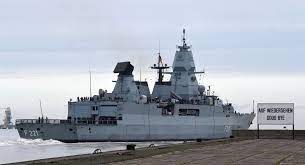Powerful German air defense frigate leaves port to join EU Red Sea mission

Brussels: Germany sent a powerful air defense frigate on Thursday to join an European Union naval mission in the Red Sea that will be launched in mid-February to protect merchant ships from attacks by Yemen’s Iran-backed Houthi militia.
Many commercial shippers have diverted vessels following attacks by the Houthis, who control much of Yemen and say they are acting in solidarity with the Palestinians as Israel and Hamas wage war in Gaza.
“Free sea trade routes are the basis of our industry and of our capability to defend ourselves,” the chief of the German navy, Vice Admiral Jan Christian Kaack, told reporters in Berlin.
For the latest updates on the Israel-Palestine conflict, visit our dedicated page.
“The current situation in the Red Sea has already caused bottlenecks in supply and forced some companies to stop their production,” he said, adding that more than 90 percent of all goods reached Europe and Germany by sea.
The United States and other countries in December launched a mission to allay fears that disruption in one of the world’s top trading arteries could hit the global economy.
But some US allies, notably European countries, have raised reservations about the plan, which has seen the US and Britain launch air strikes on Houthi positions, and baulked at the idea of being under Washington’s command.
France, Greece and Italy are among the countries that will participate in the EU mission named Aspides, meaning protector, that initially will see three vessels under EU command.
They will be mandated to protect commercial ships and intercept attacks, but not take part in strikes against the Houthis on land.
For all the latest headlines follow our Google News channel online or via the app.
The German frigate Hesse left its North Sea port of Wilhelmshaven for the Red Sea, but its participation in the mission still hinges on an EU mandate and national parliamentary approval expected at the end of February.
The vessel is built for air defense, equipped with radars that can detect targets at a range of up to 400 kms (248 miles) and missiles to shoot down targets such as ballistic missiles and drones at a range of more than 160 kms.
“We expect the entire spectrum of direct and indirect attacks, reaching from wide-ranging ballistic missiles … to drones and remote-controlled boats in kamikaze mode,” Kaack said.





